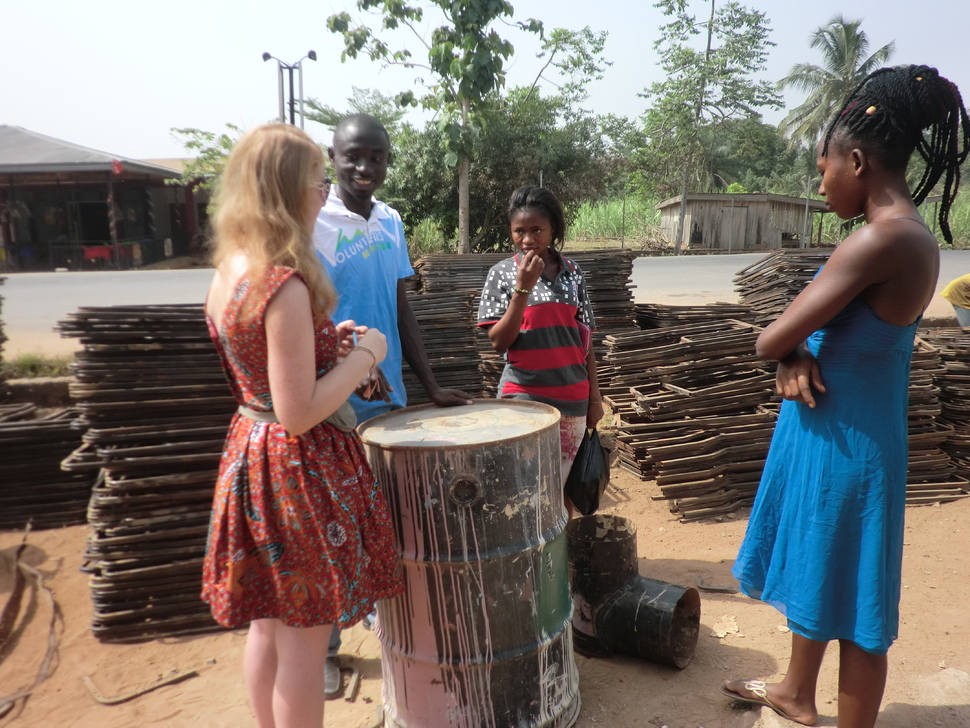Start of the internship
It is important to start the prototype phase as soon as possible, because three months is really short. Especially the first weeks are important, because during the third and fourth week the KITA students have exams and they do not have any time to work on the project then. We actually had in mind to visit the kenkey makers before we would start designing in order to make sure we would know all the design requirements, but the kenkey makers were not quite willing to show us everything. It is also difficult to interview them, because of the language problem; the kenkey makers do not speak English. If you do want to visit them, it is possible to go to Apromase (a village on a 15 minute walking distance from KITA) and visit some Ga and Fante kenkey makers over there. When you visit them to collect information, make sure that they feel that they will benefit from the conversation too, it will make them more willing to help you.
Materials
All the materials that are used to construct the cookstove are purchased by KITA. For KITA it is quite cheap and easy to purchase old paint barrels (10 GHS) or clean barrels (60 GHS) and these can be used for the main parts of the cookstove. In general there are two options for constructing a cookstove that has a barrel as basis, the combus- tion chamber can be made out of clay or metal. Both can be used in combination with insulation material like a mix of ash and rice husk, that can also be easily purchased by KITA. We made the choice to make a cookstove completely out of metal, because it is much faster and cheaper to construct than a clay stove. Combustion chambers made out of clay take a long time to build and need a month to dry. Metal is also a conductive material, which can make the stove more efficient, and it takes a very short time to construct a metal stove. Furthermore it is a benefit if the cookstove is portable and clay makes the cookstove too heavy.
It is not an option to use metal pipes for the combustion chamber, because they are extremely expensive. The metal of the barrels can be used to make pipes as well, but
only clean barrels are suitable for that because of the toxic pollutants of burnt paint that will be released into the air if you use dirty barrels. For the pot skirt an old paint barrel is acceptable.
We only used materials that were locally available, because it is quite difficult to find out what is actually available in Ghana and it takes a lot of time to go to specific plac- es in Kumasi. The store for barrels and paint is located right next to KITA. The store for iron rod and the welder’s place are located in the village of Anwomaso, which is a few kilometres away from KITA. The grid is available at KITA and otherwise it can also be purchased in nearby stores. Collecting the materials should be done by Ghanaians, because white people will pay a higher price. It takes probably a few days to collect everything. Make sure that there are clear agreements on spending the budgets and write down on all your expenses.
Construction of the prototype
The welder’s name is Colombia and he speaks Twi and a few words in English. Appoint- ments can be made by calling him, Samuel can provide his phone number.
Best is to use drawings and hand gestures to explain him the building manual. If there is no power it is not possible to weld, so it is important to take that into account when making a planning. It takes approximately 1,5 or 2 days to construct the cookstove. Things that should be brought to the welder are a measurement tape (keep in mind that the welder is more familiar with inches instead of centimetres, so check every time if he uses the right distances), a (permanent) marker and safety glasses or at least sunglasses to protect your eyes. This is not easy to find in Ghana, so it is better to bring it from the Netherlands. It is possible to use a taxi or trotro to transport the cookstove when finished.
Testing the cookstove
For testing the stove we used the water boiling test (Bailis, R., e.a., 2007). For testing a balance for weighing wood and buckets with water, a thermometer (and rope to fasten it) and a stopwatch need to be brought from the Netherlands. Make sure the thermometer can measure temperatures up to 100°C and keeps working when getting hot. The management of KITA can be asked for insulation materials. Wood, matches and enough water can be found on campus, as well as a pot with size 25. It is a good idea to check if all the materials are actually available at KITA before it is time for testing, especially the pot, because something could be missing. The tests take more than an hour and need to be performed several times.
